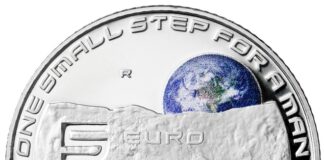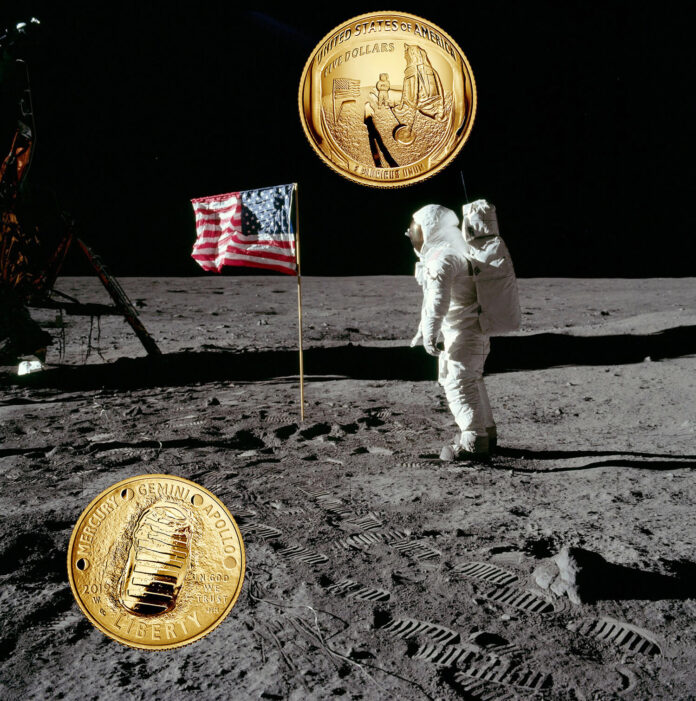
When the ‘Eagle’ landed on 21 July 1969, it truly was a giant leap for mankind. Huge, in fact. Who, before 1969, would seriously have believed that a person could land on the Moon unscathed – and then return to Earth safe and sound? Science fiction!
50 years later, the NASA mission is history, and several countries have therefore chosen to commemorate it in their coinage. Looking at these coins, we can also see just how many nations were involved in this project, in one way or another. Do you know, for example, what connects Switzerland or the little Ascension Island in the Atlantic with Apollo 11?

The US Coins: Another Race Against Time
But of course, we’ll start by focussing on the USA. The US Mint has minted four collector coins that commemorate the country’s victory in the race against Moscow to land the first man on the Moon. At first, it seemed as though this issue would have to be postponed. Why?
In 2014, the USA had minted a curved coin that caused quite a stir. The Moon landing coins also feature this extravagant curve, lending them that extra special something. For the 50 cent and 5 dollar in gold, the mint could draw on its previous experience. But for the 1 dollar coin in silver, it was rather more difficult, as the technology first had to be coordinated with the new alloy of .999 silver. So, when it came to the 5-ounce coin in silver, things got really complicated. With a diameter of 7.5 cm, this denomination was the most work-intensive. But that’s when the problems really began, as Ronald E. Harrigal, Acting Quality Manager at the US Mint, admitted in February 2019 at the Technical Forum in Berlin.
First of all, the mint had to produce enough dies. For the silver 5-ounce coin alone, which had a mintage of 100,000, experts estimated a total of 400 pairs of dies! And then the calculations began: to produce a single die, a CNC milling machine needed 11.5 hours. The hand polishing took another four hours. Producing 400 pairs of die in the estimated 90 days simply wasn’t possible. So, the Philadelphia Mint tripled its number of milling machines by purchasing four more machines.
Then the mint pulled out all the stops with state-of-the-art technology: in order to prevent any die cracks, the flow of the metal was simulated as precisely as possible on a computer. Then the chrome layer was removed from the PVD coating: this increased the lifetime of the dies by a breath-taking 4,000 percent. That meant that just 125 reverse dies and 65 obverse dies were required for the entire programme, while the working time for machine production fell to less than half. The mint team had just one more problem to solve: procuring enough suitable blanks…
But that was a success too! And now, collectors can delight in a technically ambitious coin that depicts one of the legendary footprints on the Moon on the obverse and Neil Armstrong’s astronaut helmet on the reverse, with the Moon landscape reflected in the visor. In the image, we can see Buzz Aldrin saluting the US flag.
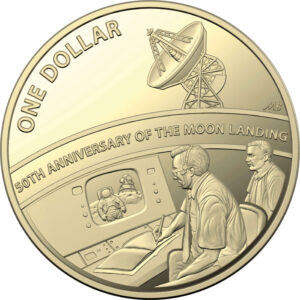
Historical Partnerships Re-Loaded
Even back in 1969, the USA depended on cooperation with partners. One of the country’s most important partners was Australia. For one simple reason: it was not possible to make direct radio contact from the USA at the moment the Eagle landed. At the time, the Earth’s satellite was located over on the opposite side of the world. A perfect opportunity for two Australian radio stations to broadcast, uninterrupted, the very first televised footage of the historic event.
This is exactly what is depicted on the Australian 1 dollar coin in the annual mint set for 2019. Together with the radio station technician, we look at the monitor in the control room of Honeysuckle Creek Tracking Station in Canberra and watch Neil Armstrong take his first steps on the Moon. The 5 cent coin in the set depicts the iconic footprint in the lunar soil.
Alongside its own product, the Royal Australian Mint will also be issuing a coin set together with the US Mint for the first time. This set will consist of a 5 dollar silver coin weighing one ounce and an American clad half dollar. The certificate of issue will be signed by the CEOs of both mints, and the mintage will be limited to 10,000. The mints are yet to reveal this collaborative set, so collectors will have to wait for just a little longer.
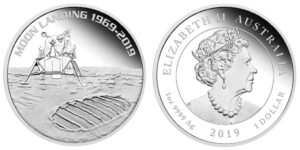
The Moon Landing As an Investment Opportunity
The private Perth Mint in Australia is also issuing coins to commemorate the Moon landing. Here, coin lovers can choose between collector coins and an investment option (bullion coins). For investors, there is a gold and silver coin, each weighing one ounce; for collectors, there are commemorative coins with the same motif, for example, a 5-ounce version in silver with especially high relief, or in gold. The legendary footprint is once again prominent in the foreground of all the coins, with the Lunar Module Eagle in the background.
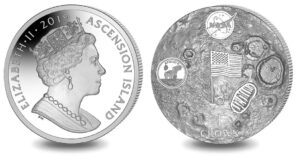
Partnerships in the Atlantic and the Alps
But there were also other countries involved fifty years ago. For instance, little Ascension Island, located in the middle of the Atlantic Ocean, is home to a military airbase jointly operated by the American and British air forces. The Devil’s Ashpit was ideally located to precisely monitor the action happening over 380,000 kilometres away, as the surrounding peaks largely shield the area against any kind of radar or other radio-frequency interference. This is commemorated by the weighty piedfort coin, limited to 650 pieces, which was minted for the island by the private British mint Pobjoy Mint. The Brits were granted a special permit from NASA that allowed them to feature the ‘meatball’ – the famous NASA logo – and the badge of the Apollo 11 mission on the obverse. The relief on the obverse is especially high and curves towards the centre.
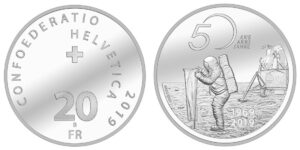
It may be difficult to believe, but back before the US flag had even been hoisted on the Moon, Switzerland was involved! On behalf of the Bern Physics Institute, Buzz Aldrin set up a so-called solar sail, a special structure designed to capture particles that would prove the existence of solar winds, which had previously only been described in theory. The experiment actually succeeded and was repeated on other expeditions. It was the only non-American experiment conducted during the Apollo 11 mission. The engraver at Swissmint, Remo Mascherini, therefore chose to depict a completely different moment than the other mints: Buzz Aldrin setting up the solar sail, made in Switzerland.
The Moon Landing Unites Mankind
But even countries that weren’t directly involved in the Moon expedition of 1969 are minting and issuing coins. It’s like a world heritage site for all mankind: the Moon landing represents a great accomplishment for all of humanity.

In the same way that humans’ conquest of outer space kept overcoming new technical hurdles, Austria has masterfully risen to the challenge of producing a fully convex coin, just like the USA. The outer side of the 20 euro coin depicts the Moon landscape, while on the inner side, we look past one of the astronauts and his Eagle into the depths of space, where our colourful home planet shines brightly. The mint used a special technique to make the individual stars glow green in the dark, while the surrounding universe appears black.

This coin by Degussa is designed rather differently; collectors can choose between versions in gold, silver and silver with an antique finish. As the coin is issued as a ‘taler’, the reverse of which depicts the eagle from the coat of arms of Frankfurt, based on a model from the 1840s, the obverse is also complete with a fitting and stylish design depicting the key moment: the first man on the Moon, with the Earth far off in the background. And best of all: the boxes for the first 50 gold coins will also contain a piece of the Moon meteorite “NWA 11047,” which hit the Sahara in spring 2017 – a little greeting from outer space.
This absolute tour de force goes to show that any coin lover wanting to reminisce about the Moon landing, or looking to bring new, incredible feats of minting technology into their own home, has a very wide range of coins to choose from.
This article was published originally in German in MünzenMarkt 27 in April 2019. You can download the German issue from our website (die ursprüngliche deutsche Version können Sie in diesem MünzenMarkt lesen).
If you happened to miss the moon landing back then live, you can always watch it on Youtube.
The second man on moon was Buzz Aldrin. In this Youtube clip he recalls the Apollo 11 Mission.
The Swissmint coin showing Buzz Aldrin setting up the solar sail is also in the Cosmos of Collectibles database.



